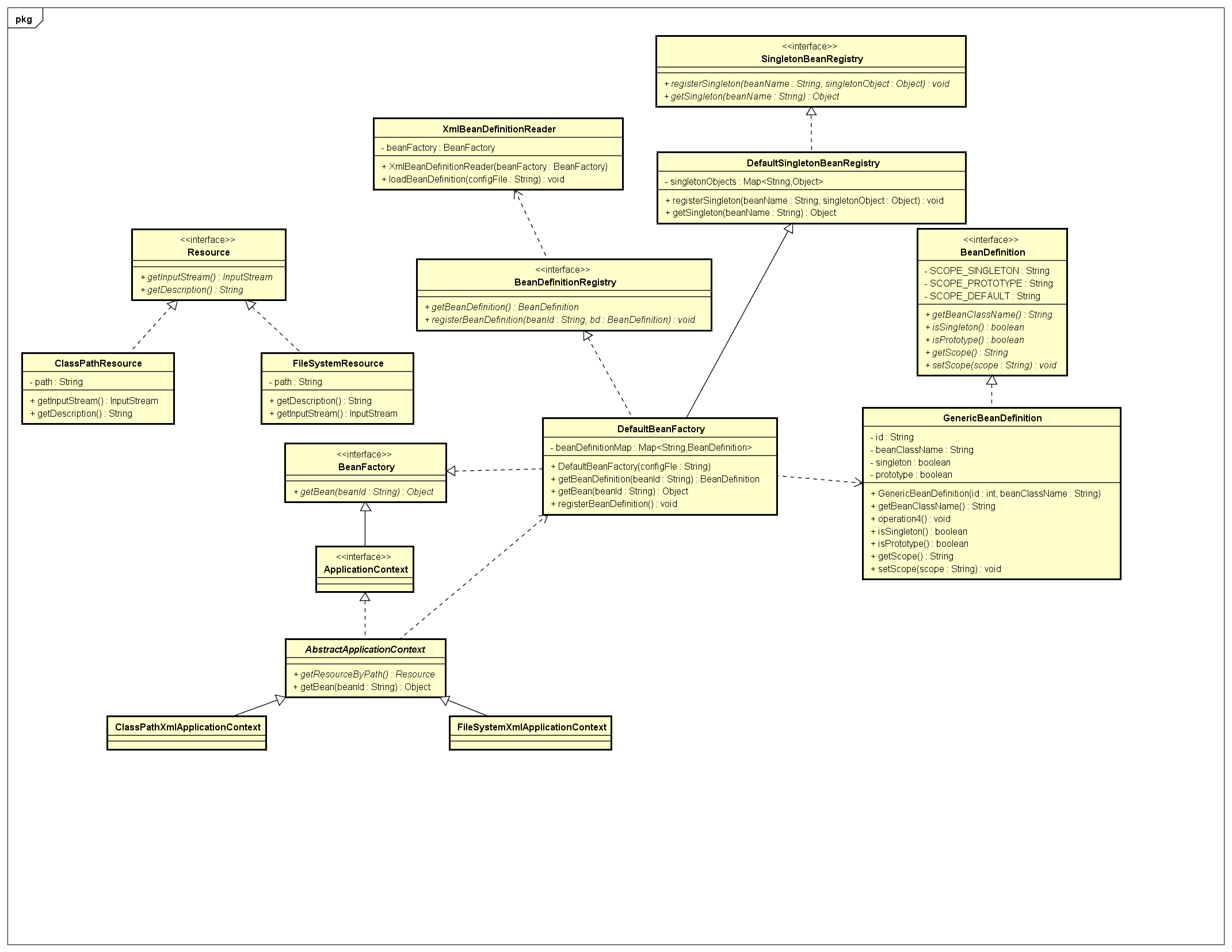愿君多采撷,此物最相思。
概述
在Small Spring系列一:BeanFactory(一)中,我们用DefaultBeanFactory读取bean.xlm中的bean信息,并且也实现了BeanFactory的getBean()方法。但是实现的方式有些不友好,本章,我们将优化和完善BeanFactory。
问题
你会发现在DefaultBeanFactory中存在读取bean.xml和反射创建对象两种操作,这不符合设计模式的单一职责。因此我们新增加一个XmlBeanDefinitionReader来读取bean.xml。但解析的BeanDefinition如何交给BeanFactory处理呢?这里我们可以在BeanFactory接口中增加registerBeanDefinition(String beanID, BeanDefinition bd)方法,将XmlBeanDefinitionReader解析的BeanDefinition注册到BeanFactory中。(此时XmlBeanDefinitionReader中需要持有一个BeanFactory的实例)。类图如下:
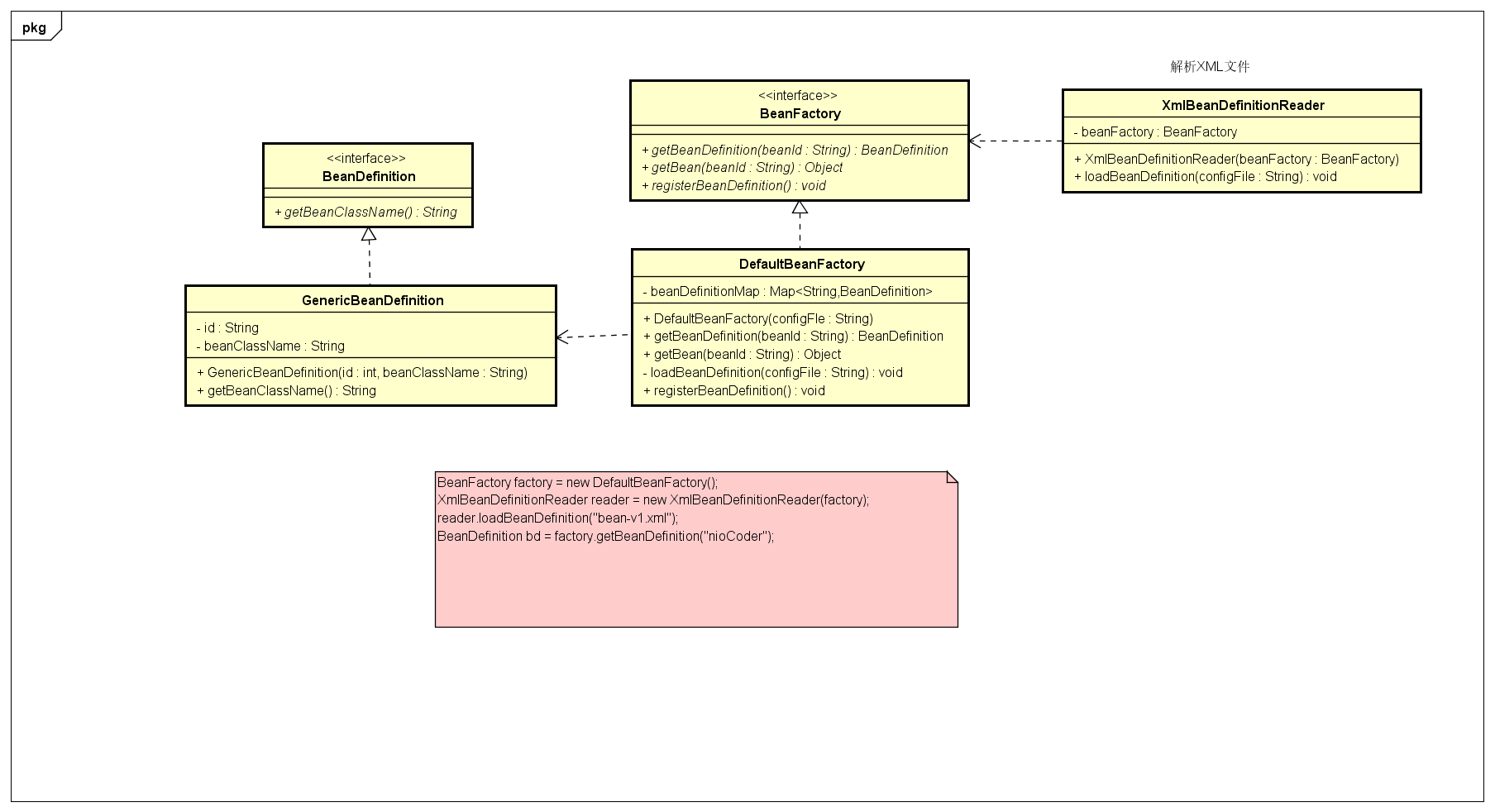
BeanFactory
/**
* 创建bean的实例
* @author zhenglongfei
*/
public interface BeanFactory {
/**
* 获取bean的定义
* @param beanId
* @return
*/
BeanDefinition getBeanDefinition(String beanId);
/**
* 获取bean的实例
* @param beanId
* @return
*/
Object getBean(String beanId);
/**
* 注册 BeanDefinition
* @param beanID
* @param bd
*/
void registerBeanDefinition(String beanID, BeanDefinition bd);
}
增加registerBeanDefinition(String beanID, BeanDefinition bd)方法
DefaultBeanFactory
/**
* BeanFactory的默认实现类
*
* @author zhenglongfei
*/
public class DefaultBeanFactory implements BeanFactory {
/**
* 存放BeanDefinition
*/
private final Map<String, BeanDefinition> beanDefinitionMap = new ConcurrentHashMap<>();
@Override
public BeanDefinition getBeanDefinition(String beanId) {
return this.beanDefinitionMap.get(beanId);
}
@Override
public Object getBean(String beanId) {
BeanDefinition bd = this.getBeanDefinition(beanId);
if (bd == null) {
throw new BeanCreationException("BeanDefinition does not exist");
}
ClassLoader cl = ClassUtils.getDefaultClassLoader();
String beanClassName = bd.getBeanClassName();
try {
// 使用反射创建bean的实例,需要对象存在默认的无参构造方法
Class<?> clz = cl.loadClass(beanClassName);
return clz.newInstance();
} catch (Exception e) {
throw new BeanCreationException("Bean Definition does not exist");
}
}
@Override
public void registerBeanDefinition(String beanID, BeanDefinition bd) {
this.beanDefinitionMap.put(beanID, bd);
}
}
去除loadBeanDefinition方法
XmlBeanDefinitionReader
读取解析bean.xml文件
/**
* @author zhenglongfei
*/
public class XmlBeanDefinitionReader {
private static final String ID_ATTRIBUTE = "id";
private static final String CLASS_ATTRIBUTE = "class";
BeanFactory beanFactory;
public XmlBeanDefinitionReader(BeanFactory beanFactory) {
this.beanFactory = beanFactory;
}
/**
* 具体解析bean.xml的方法 使用dom4j
*
* @param configFile
*/
public void loadBeanDefinition(String configFile) {
ClassLoader cl = ClassUtils.getDefaultClassLoader();
try (InputStream is = cl.getResourceAsStream(configFile)) {
SAXReader reader = new SAXReader();
Document doc = reader.read(is);
Element root = doc.getRootElement();
Iterator<Element> elementIterator = root.elementIterator();
while (elementIterator.hasNext()) {
Element ele = elementIterator.next();
String id = ele.attributeValue(ID_ATTRIBUTE);
String beanClassName = ele.attributeValue(CLASS_ATTRIBUTE);
BeanDefinition bd = new GenericBeanDefinition(id, beanClassName);
this.beanFactory.registerBeanDefinition(id, bd);
}
} catch (Exception e) {
throw new BeanDefinitionStoreException("IOException parsing XML document", e);
}
}
}
持有BeanFactory实例,解析bean.xml之后调用registerBeanDefinition(id, bd)将BeanDefinition注册到BeanFactory中
BeanFactoryTest
修改测试类
/**
* BeanFactory 测试类
*/
public class BeanFactoryTest {
/**
* 测试获取bean
*/
@Test
public void testGetBean() {
BeanFactory factory = new DefaultBeanFactory();
XmlBeanDefinitionReader reader = new XmlBeanDefinitionReader(factory);
reader.loadBeanDefinition("bean-v1.xml");
BeanDefinition bd = factory.getBeanDefinition("nioCoder");
assertEquals("com.niocoder.service.v1.NioCoderService", bd.getBeanClassName());
NioCoderService nioCoderService = (NioCoderService) factory.getBean("nioCoder");
assertNotNull(nioCoderService);
}
/**
* 测试无效的bean
*/
@Test
public void testInvalidBean() {
BeanFactory factory = new DefaultBeanFactory();
XmlBeanDefinitionReader reader = new XmlBeanDefinitionReader(factory);
reader.loadBeanDefinition("bean-v1.xml");
try {
factory.getBean("invalidBean");
} catch (BeanCreationException e) {
return;
}
Assert.fail("expect BeanCreationException ");
}
/**
* 测试无效的xml
*/
@Test
public void testInvalidXML() {
try {
BeanFactory factory = new DefaultBeanFactory();
XmlBeanDefinitionReader reader = new XmlBeanDefinitionReader(factory);
reader.loadBeanDefinition("bean.xml");
} catch (BeanDefinitionStoreException e) {
return;
}
Assert.fail("expect BeanDefinitionStoreException ");
}
}
使用XmlBeanDefinitionReader读取bean.xml
代码下载
优化1.0
我们再来重新审视一下BeanFactory接口中的方法,它现在除了getBean(String beanId)方法之外,还有getBeanDefinition(String beanId)和registerBeanDefinition(String beanID, BeanDefinition bd)。registerBeanDefinition()是用于XmlBeanDefinitionReader使用的,XmlBeanDefinitionReader持有BeanFactory的实例,那么它也会知道BeanFactory的getBean()方法,并且BeanFactory我们只想用它来获取bean的实例,不想对外暴露太多,所以我们新增一个BeanDefinitionRegistry接口来注册和获取BeanDefinition。类图如下
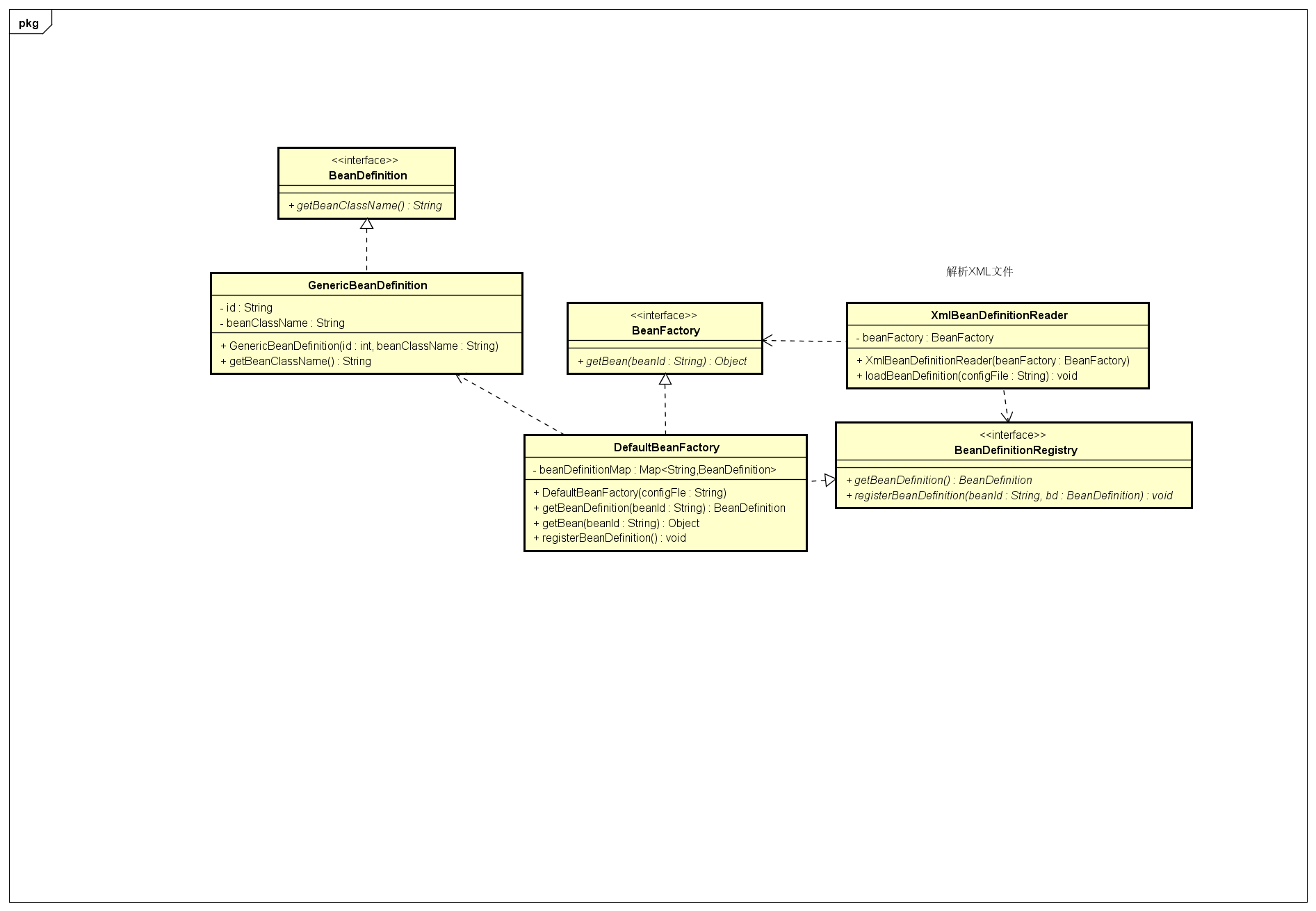
BeanFactory
/**
* 创建bean的实例
* @author zhenglongfei
*/
public interface BeanFactory {
/**
* 获取bean的实例
* @param beanId
* @return
*/
Object getBean(String beanId);
}
只保留getBean方法
BeanDefinitionRegistry
/**
* 注册BeanDefinition接口
*
* @author zhenglongfei
*/
public interface BeanDefinitionRegistry {
/**
* 获取beanDefinition
*
* @param beanId
* @return
*/
BeanDefinition getBeanDefinition(String beanId);
/**
* 注册beanDefinition
*
* @param beanId
* @param bd
*/
void registerBeanDefinition(String beanId, BeanDefinition bd);
}
把原先BeanFactory中getBeanDefinition()和registerBeanDefinition()提取到BeanDefinitionRegistry接口中
DefaultBeanFactory
public class DefaultBeanFactory implements BeanFactory, BeanDefinitionRegistry{
... ...
}
实现了BeanDefinitionRegistry接口
XmlBeanDefinitionReader
public class XmlBeanDefinitionReader{
......
BeanDefinitionRegistry registry;
public XmlBeanDefinitionReader(BeanDefinitionRegistry registry) {
this.registry = registry;
}
public void loadBeanDefinition(String configFile){
... ...
this.registry.registerBeanDefinition(id, bd);
}
}
由BeanFactory变成BeanDefinitionRegistry实例
代码下载
优化2.0.1
观察一下测试类BeanFactoryTest,当我们每次使用BeanFactory获取实例时,都需要使用到XmlBeanDefinitionReader的loadBeanDefinition方法。这有一些麻烦,我们该如何封装一下呢?这里我们新增一个ApplicationContext接口来封装这些操作。但由于配置文件的不确定性,有的可能存在classpath目录下,有的可能存在磁盘的目录下,又或者内存,网络等等。这里我们就简单的实现从classpath和磁盘目录两种情况。对应的ClassPathXmlApplicationContext和FileSystemXmlApplicationContext。由于ClassPathXmlApplicationContext和FileSystemXmlApplicationContext都需要读取文件,所以我们提取出来一个Resource接口,类图如下:
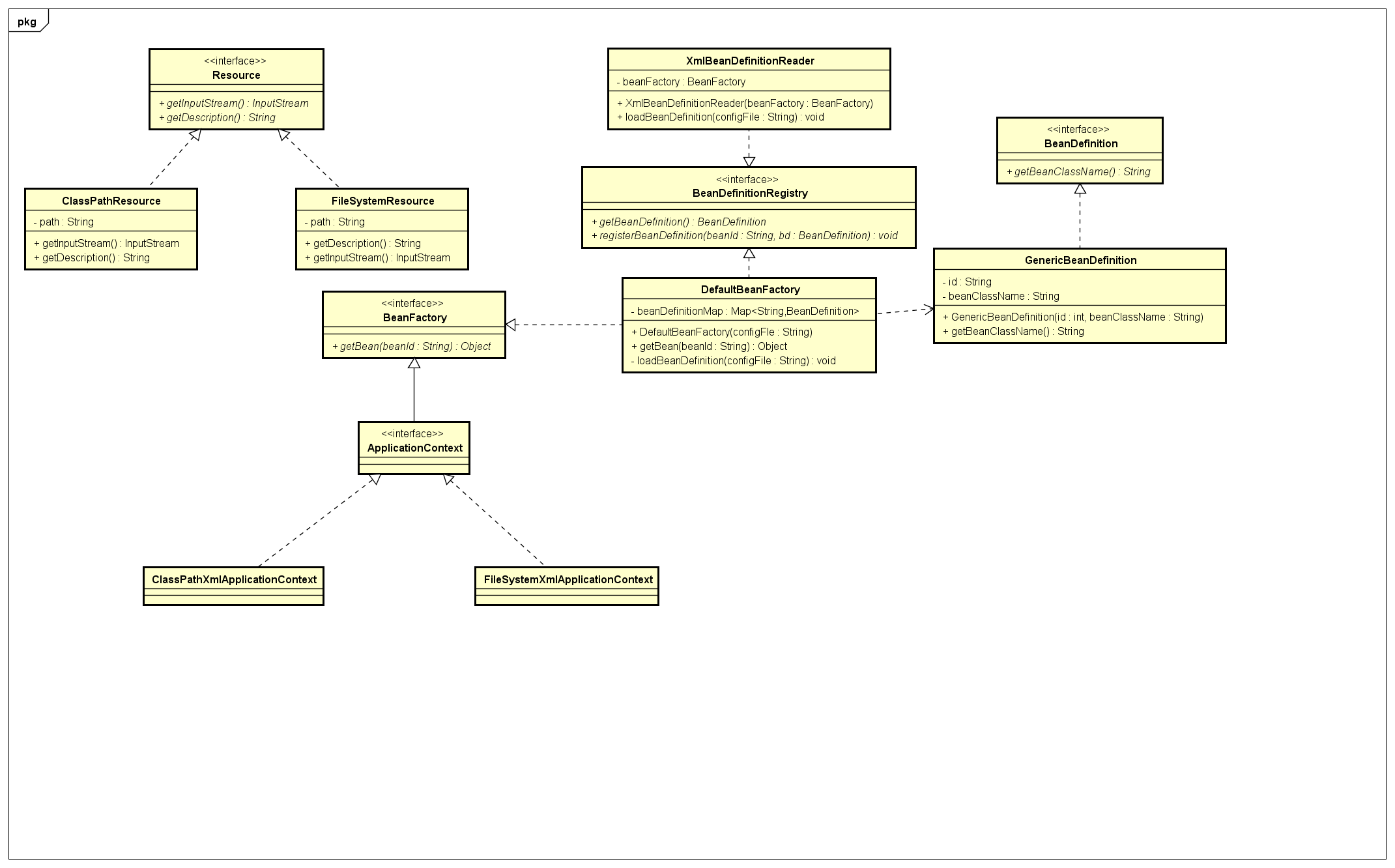
Resource
/**
* 抽取一个资源接口
*
* @author zhenglongfei
*/
public interface Resource {
/**
* 获取一个流
* @return
* @throws IOException
*/
InputStream getInputStream() throws IOException;
/**
* 获取文件的描述
* @return
*/
String getDescription();
}
提取一个获取资源的接口
ClassPathResource
public class ClassPathResource implements Resource {
private String path;
public ClassPathResource(String path) {
this.path = path;
}
@Override
public InputStream getInputStream() throws IOException {
InputStream is = ClassUtils.getDefaultClassLoader().getResourceAsStream(this.path);
if (is == null) {
throw new FileNotFoundException(path + " cannot be opened");
}
return is;
}
@Override
public String getDescription() {
return this.path;
}
}
从classpath下获取资源
FileSystemResource
public class FileSystemResource implements Resource {
private String path;
private File file;
public FileSystemResource(String path) {
this.path = path;
this.file = new File(path);
}
@Override
public InputStream getInputStream() throws IOException {
return new FileInputStream(this.file);
}
@Override
public String getDescription() {
return this.file.getAbsolutePath();
}
}
从磁盘目录下获取资源
XmlBeanDefinitionReader
public class XmlBeanDefinitionReader {
......
public void loadBeanDefinition(Resource resource) {
try (InputStream is = resource.getInputStream()) {
SAXReader reader = new SAXReader();
Document doc = reader.read(is);
Element root = doc.getRootElement();
Iterator<Element> elementIterator = root.elementIterator();
while (elementIterator.hasNext()) {
Element ele = elementIterator.next();
String id = ele.attributeValue(ID_ATTRIBUTE);
String beanClassName = ele.attributeValue(CLASS_ATTRIBUTE);
BeanDefinition bd = new GenericBeanDefinition(id, beanClassName);
this.registry.registerBeanDefinition(id, bd);
}
} catch (Exception e) {
throw new BeanDefinitionStoreException("IOException parsing XML document", e);
}
}
......
}
将参数修改为Resource
ApplicationContext
public interface ApplicationContext extends BeanFactory {
}
用于封装读取和解析bean.xml操作的接口
ClassPathXmlApplicationContext
public class ClassPathXmlApplicationContext implements ApplicationContext {
private DefaultBeanFactory factory = null;
public ClassPathXmlApplicationContext(String configFile) {
factory = new DefaultBeanFactory();
XmlBeanDefinitionReader reader = new XmlBeanDefinitionReader(factory);
Resource resource = new ClassPathResource(configFile);
reader.loadBeanDefinition(resource);
}
@Override
public Object getBean(String beanId) {
return factory.getBean(beanId);
}
}
从classpath下读取 bean.xml
FileSystemXmlApplicationContext
public class FileSystemXmlApplicationContext implements ApplicationContext {
private DefaultBeanFactory factory = null;
public FileSystemXmlApplicationContext(String configFile) {
factory = new DefaultBeanFactory();
XmlBeanDefinitionReader reader = new XmlBeanDefinitionReader(factory);
Resource resource = new FileSystemResource(configFile);
reader.loadBeanDefinition(resource);
}
@Override
public Object getBean(String beanId) {
return factory.getBean(beanId);
}
}
从系统磁盘目录读取文件
ApplicationContextTest
public class ApplicationContextTest {
@Test
public void testGetBeanFromClassPathContext() {
ApplicationContext context = new ClassPathXmlApplicationContext("bean-v1.xml");
NioCoderService nioCoderService = (NioCoderService) context.getBean("nioCoder");
Assert.assertNotNull(nioCoderService);
}
@Test
public void testGetBeanFromFileSystemContext() {
ApplicationContext context = new FileSystemXmlApplicationContext("src/test/resources/bean-v1.xml");
NioCoderService nioCoderService = (NioCoderService) context.getBean("nioCoder");
Assert.assertNotNull(nioCoderService);
}
}
测试ClassPathXmlApplicationContext和FileSystemXmlApplicationContext
代码下载
优化2.0.2
重复代码时万恶之源。在 ClassPathXmlApplicationContext和FileSystemXmlApplicationContext的 的构造方法中有冗余代码,因此我们可以考虑使用模板方法来处理一下。类图如下:
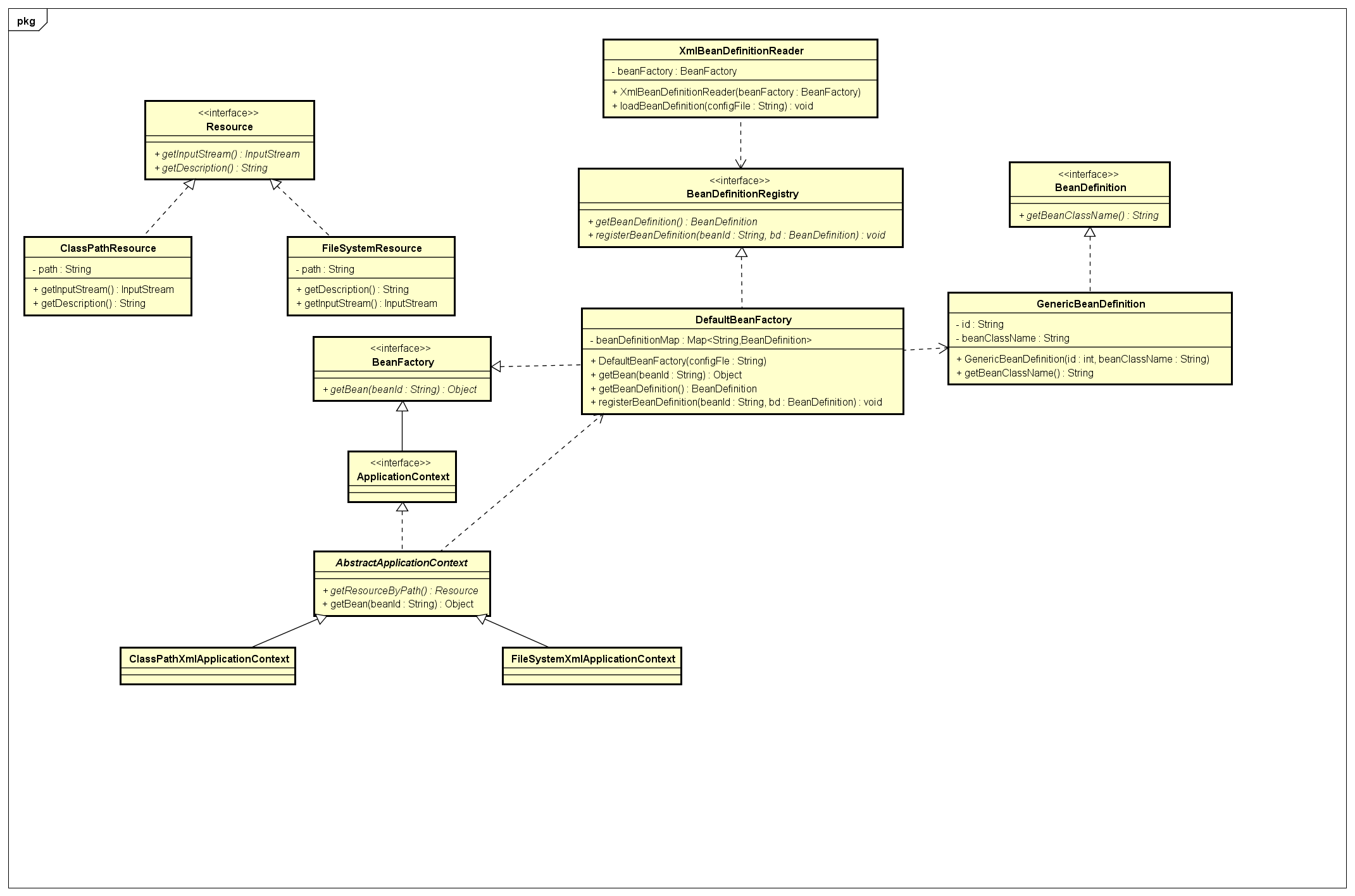
AbstractApplicationContext
public abstract class AbstractApplicationContext implements ApplicationContext {
private DefaultBeanFactory factory = null;
public AbstractApplicationContext(String configFile) {
factory = new DefaultBeanFactory();
XmlBeanDefinitionReader reader = new XmlBeanDefinitionReader(factory);
Resource resource = this.getResourceByPath(configFile);
reader.loadBeanDefinition(resource);
}
/**
* 具体由子类实现
*
* @param configFile
* @return
*/
protected abstract Resource getResourceByPath(String configFile);
@Override
public Object getBean(String beanId) {
return factory.getBean(beanId);
}
}
新增AbstractApplicationContext抽象类,里面增加getResourceByPath抽象方法
ClassPathXmlApplicationContext
public class ClassPathXmlApplicationContext extends AbstractApplicationContext {
public ClassPathXmlApplicationContext(String configFile) {
super(configFile);
}
@Override
protected Resource getResourceByPath(String configFile) {
return new ClassPathResource(configFile);
}
}
返回ClassPathResource
FileSystemXmlApplicationContext
public class FileSystemXmlApplicationContext extends AbstractApplicationContext {
public FileSystemXmlApplicationContext(String configFile) {
super(configFile);
}
@Override
protected Resource getResourceByPath(String configFile) {
return new FileSystemResource(configFile);
}
}
返回FileSystemResource
代码下载
优化3.0
至此已经完成了增加BeanDefinitionRegistry实现接口单一职责,ApplicationContext封装bean.xml的解析和实例化。接下来我们来处理scope的问题。这里我们只是简单区分一下一个bean是否单例。为了实现接口细粒度化,我们新增SingletonBeanRegistry来区分一个bean是否单例。类图如下:
BeanDefinition
public interface BeanDefinition {
/**
* 单例
*/
String SCOPE_SINGLETON = "singleton";
/**
* 多例
*/
String SCOPE_PROTOTYPE = "prototype";
/**
* 默认为空即单例模式
*/
String SCOPE_DEFAULT = "";
/**
* 是否为单例
*
* @return
*/
boolean isSingleton();
/**
* 是否为多例
*
* @return
*/
boolean isPrototype();
/**
* 获取scope配置
*
* @return
*/
String getScope();
/**
* 设置scope
*
* @param scope
*/
void setScope(String scope);
/**
* 获取bean.xml中 bean的全名 如 "com.niocoder.service.v1.NioCoderService"
*
* @return
*/
String getBeanClassName();
}
单例多例为bean的属性,所以需要修该BeanDefinition
GenericBeanDefinition
public class GenericBeanDefinition implements BeanDefinition {
private String id;
private String beanClassName;
private boolean singleton = true;
private boolean prototype = false;
private String scope = SCOPE_DEFAULT;
public GenericBeanDefinition(String id, String beanClassName) {
this.id = id;
this.beanClassName = beanClassName;
}
@Override
public boolean isSingleton() {
return this.singleton;
}
@Override
public boolean isPrototype() {
return this.prototype;
}
@Override
public String getScope() {
return scope;
}
@Override
public void setScope(String scope) {
this.scope = scope;
this.singleton = SCOPE_SINGLETON.equals(scope) || SCOPE_DEFAULT.equals(scope);
this.prototype = SCOPE_PROTOTYPE.equals(scope);
}
@Override
public String getBeanClassName() {
return this.beanClassName;
}
}
修改BeanDefinition的实现
XmlBeanDefinitionReader
public class XmlBeanDefinitionReader {
public void loadBeanDefinition(Resource resource) {
......
if (ele.attribute(SCOPE_ATTRIBUTE) != null) {
bd.setScope(ele.attributeValue(SCOPE_ATTRIBUTE));
}
this.registry.registerBeanDefinition(id, bd);
......
}
}
如果bean.xml中配置scope属性则设置scope
SingletonBeanRegistry
public interface SingletonBeanRegistry {
/**
* singlebean 注册
*
* @param beanName
* @param singletonObject
*/
void registerSingleton(String beanName, Object singletonObject);
/**
* 获取singlebean
*
* @param beanName
* @return
*/
Object getSingleton(String beanName);
}
表示bean 为singleton的接口
DefaultSingletonBeanRegistry
public class DefaultSingletonBeanRegistry implements SingletonBeanRegistry {
private final Map<String, Object> singletonObjects = new ConcurrentHashMap<>(64);
@Override
public void registerSingleton(String beanName, Object singletonObject) {
Assert.notNull(beanName, "'beanName' must not be null");
Object oldObject = this.singletonObjects.get(beanName);
if (oldObject != null) {
throw new IllegalStateException("Could not register object [" + singletonObject +
"] under bean name '" + beanName + "': there is already object [" + oldObject + "] bound");
}
this.singletonObjects.put(beanName, singletonObject);
}
@Override
public Object getSingleton(String beanName) {
return this.singletonObjects.get(beanName);
}
}
SingletonBeanRegistry的实现类
DefaultBeanFactory
public class DefaultBeanFactory extends DefaultSingletonBeanRegistry implements BeanFactory, BeanDefinitionRegistry {
......
@Override
public Object getBean(String beanId) {
BeanDefinition bd = this.getBeanDefinition(beanId);
if(bd == null){
return null;
}
if(bd.isSingleton()){
Object bean = this.getSingleton(beanId);
if(bean == null){
bean = createBean(bd);
this.registerSingleton(beanId, bean);
}
return bean;
}
return createBean(bd);
}
private Object createBean(BeanDefinition bd) {
ClassLoader cl = ClassUtils.getDefaultClassLoader();
String beanClassName = bd.getBeanClassName();
try {
Class<?> clz = cl.loadClass(beanClassName);
// 使用反射创建bean的实例,需要对象存在默认的无参构造方法
return clz.newInstance();
} catch (Exception e) {
throw new BeanCreationException("create bean for "+ beanClassName +" failed",e);
}
}
......
}
getBean时判断是否为singleton
BeanFactoryTest
public class BeanFactoryTest {
......
/**
* 测试获取bean
*/
@Test
public void testGetBean() {
reader.loadBeanDefinition(new ClassPathResource("bean-v1.xml"));
BeanDefinition bd = factory.getBeanDefinition("nioCoder");
assertTrue(bd.isSingleton());
assertFalse(bd.isPrototype());
assertEquals(BeanDefinition.SCOPE_DEFAULT, bd.getScope());
assertEquals("com.niocoder.service.v1.NioCoderService", bd.getBeanClassName());
NioCoderService nioCoderService = (NioCoderService) factory.getBean("nioCoder");
assertNotNull(nioCoderService);
NioCoderService nioCoderService1 = (NioCoderService) factory.getBean("nioCoder");
assertTrue(nioCoderService.equals(nioCoderService1));
}
......
}
测试默认的bean getBean时判断是否为singleton

